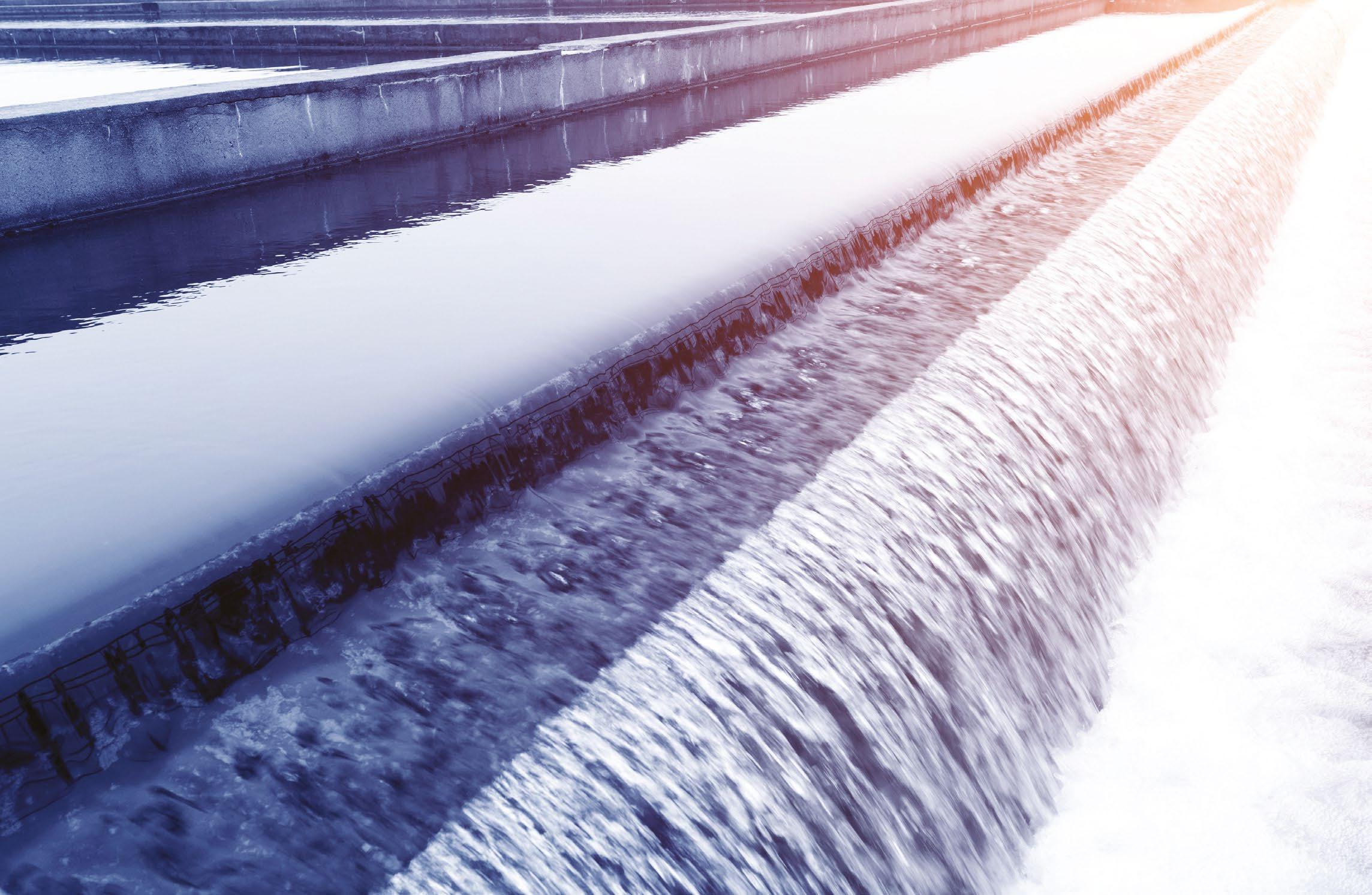
6 minute read
Preparing for an Uncertain Water Future - Aquatech Executive Chairman, Venkee Sharma
Advertisement
We caught up with Lotta Kanto Öqvist, Chief Sustainability Officer at Solenis, to find out how they are helping their business, customers and society prepare for an uncertain water future.

How will climate change impact your business? Climate change will increase water scarcity in some areas, reduce the amount of fresh water and process water available, and cause more extreme weather and flooding events.
This presents a huge challenge and will force our customers to adapt to changes in both water quality and quantity.
It also presents us with an opportunity. For more than 100 years, we have been driving value for our customers by helping them solve complex water treatment and process improvement challenges. As such, we are well positioned to help our customers improve the efficiency of their operations and optimize their use, reuse, and recycling of water. How do your solutions help your customers adapt? Our customers, which include paper manufactures, power producers, petroleum refiners, chemical processing operations and more, use millions of liters of water daily. We make sure that the water they use is fit for purpose and the water that flows out of the facility back into the environment is as clean, if not cleaner, than before.
Optimizing the process allows manufacturers to reuse more water, reduce overall water intake, cut emissions, and minimize waste.
For instance, our ClearPointSM biofilm detection and control program improves our customers’ waterrelated environmental performance by helping them to use their freshwater more efficiently, thereby conserving water. Additionally, the program offers the following benefits: reduced corrosion rates, reduced halogenated organics and reduced operating costs.
We are also working on several innovative digital solutions that enable our customers to map their water use across their entire operation so they can identify opportunities for optimization. This data provides insights that enables our customers to be more resilient to climate threats.

What is the role of water-tech innovation in climate adaptation? Technologies and innovations that enable waterintensive industries to adapt to a new water reality are key.
We provide many differentiated chemical and digital technologies that make industrial processes more efficient, including innovative chemistries for controlling scale, corrosion and microorganisms and advanced monitoring and control systems for optimizing the performance of water and wastewater treatment programs.
We also work with venture capital firms who help us look for early-stage companies and startups who have developed cutting-edge technologies that can improve the sustainability of our customers. We may partner with these companies or may acquire them.
To help our customers tackle their challenges, we must provide them with the best technologies, which is why these partnerships and acquisitions are so important.
How should society and industry tackle the climate challenge going forward? We need to broaden our perspective. Climate change is not just about decarbonizing the energy system. Many of its greatest impacts will be felt in the way water is distributed globally and this is a reality we must adapt to.
One thing is certain, digital technologies will be central to climate adaptation. The data and insights these tools provide offer situational awareness about water use, which empowers all that use water to manage it more efficiently.
Finally, we need to work together across industries and between governments, sectors and the public. We cannot adapt to climate change without an “all-handson-deck” approach.
Trust the Experts. Trust ATi.
Our expertise in water quality sensor design and manufacture allows us to offer unparalleled reliability, accuracy and sustainability across multiple sectors for optimal control of critical processes.
Potable Water / Wastewater / Industrial / Food & Beverage / Healthcare / HVAC



M-Node water quality sensors sales@atiuk.com +44 (0) 1457 873 318 analyticaltechnology.com
Solutions for a Smarter Future

Metrics to Monitor Climate Adaptation

The decarbonisation side of ClimateTech enjoys a relatively straightforward set of metrics around greenhouse gas (GHG) emissions.
‘‘“Wind and heat certainly matter, but quantification of climate risk is largely a story of water risk. Multi-variable ‘scoring’ of a region, a city, a neighbourhood, Whether renewable energy, energy efficiency, or carbon sequestration, investors, corporates, and a wide range of stakeholders operate under the same goal: less, or ideally no carbon emissions. This is measurable under global standards. Measuring adaptation is slightly more challenging because there are such a broad range of ‘assets’ facing risks associated with changed climate. However, there is a growing realisation that measuring climate risk and our ability to adapt is critical, as evidenced by the U.S, SEC’s proposal for Climate Change Disclosure where they state: “We believe that disclosure of the material and systemic risks of climate change will help companies and investors to understand, price, and manage climate risks and opportunities.” Understandably, the finance and insurance sectors sit near the centre of climate risk, and are actively or specific asset is humanity’s most effective metric for understanding risks associated with a changed climate. Chris Peacock, CEO, AQUAOSO seeking innovations to help manage and mitigate the outcomes of a changed climate. Success metrics in Climate Adaptation side of ClimateTech are a function of the specific market and application. Metrics are often categorised in 3 ways:

Improvements in water ratio, e.g. less fresh water per car manufactured, per household per month, per gallon of beer produced, per bushel of wheat produced, etc.
Reduction in financial loss due to water ‘events’, e.g. flooding, drought, property and infrastructure damage.
Quantifiable improvements in drinking, waste, and stormwater compliance (e.g. less violations)
Smart water treatment
Water treatment plants can unlock significant savings without making a single upgrade to their infrastructure. How? Through what Pani Energy CEO, Devesh Bharadwaj, calls ‘process optimisation intelligence’. We sat down with Devesh to find out more…
What is Pani all about? Pani is a Canadian software company helping water treatment facilities reduce their operating risk, cost, carbon emissions and water usage.
We do this through our AI-based software that works as a decision-making tool for operators and helps them reduce their operating cost by up to 20% and risk by up to 20%.
We’ve helped our customers save millions of litres per year without a single hardware change.
Why do water treatment plants need this tech? Many facilities have trouble managing their operations efficiently. They are firefighting increasing risks, costs, water supply shortages, and greenhouse gas emissions on a daily basis. This is largely due to a lack of digitisation. Over the years the hardware for water treatment has advanced, but the software has not caught up. This means that most facilities simply don’t have access to the data they need to make informed decisions.
How are you disrupting the status quo? We are breaking down silos and antiquated ways of working by accelerating the digital transformation of water treatment plants.
Our AI-driven software helps plants optimise their processes through actionable insights - unlocking hidden value from their existing infrastructure.
We know that not every plant has the resources to start their digital journey, which is why we have adopted a purely SaaS model that requires no capex. We use a plant’s existing sensor network as well, meeting the facility where they are.
How can you help operators adapt to climate change? Water treatment has a role to play in both mitigation and adaptation.
On the mitigation side, water treatment accounts for a lot of emissions and as the impacts of climate change










